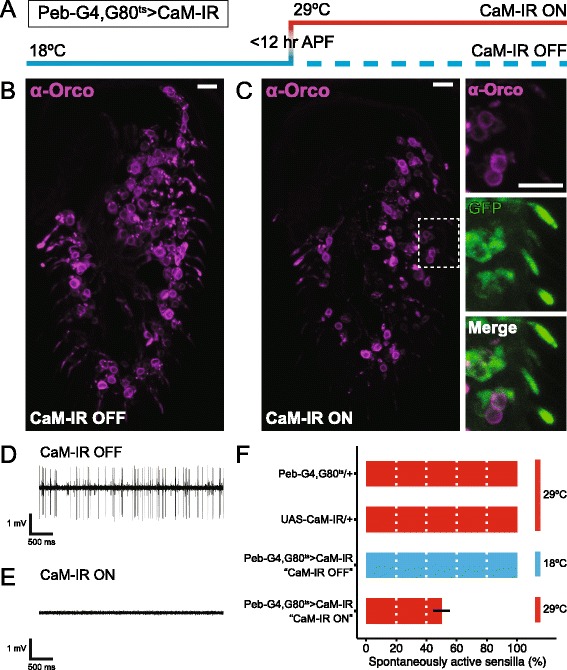Fig. 1.

CaM knock-down reduces Orco protein levels and eliminates OSN spontaneous activity. a Schematic showing the temperature changes used to restrict CaM knock-down to adult olfactory neurons. At 18 °C, tub-GAL80ts represses Peb-GAL4’s activation of CaM-IR expression. Since adult OSN development begins 0–12 hours after puparium formation (APF), we chose this time window to shift the Peb-GAL4, tub-GAL80 ts > UAS-CaM-IR flies from 18 °C to 29 °C to inactivate GAL80 and activate CaM knock-down (CaM-IR ON). We maintained the CaM-IR OFF control flies at 18 °C throughout adulthood. b, c Staining of antennal sections from Peb-GAL4, UAS-Dcr-2/+; tub-GAL80 ts /UAS-CaM-IR; UAS-myR::GFP/+ flies with an Orco-specific antibody. Scale bars, 10 μm. b CaM-IR OFF control flies show normal Orco protein signal in the OSN soma and ciliated dendrites. c CaM-IR ON flies show reduced Orco signal in the OSN soma and the ciliated dendrites. This occurs despite normal OSN dendritic morphology, confirmed via visualization of the membrane-tethered myR::GFP in the high-magnification views on the right. d Sample spike trace from a typical CaM-IR OFF ab2 sensillum. Note the large ab2A spikes and the smaller ab2B spikes. e Sample trace from a CaM-IR ON large basiconic sensillum that lacks all spontaneous activity. f Percentage of large basiconic sensilla from flies of the indicated genotypes maintained at the indicated temperatures that show spontaneous activity. While all sensilla from the control flies show normal spontaneous activity, only ~50 % of the sensilla from CaM-IR ON flies show spontaneous activity. Data are presented as means ± standard error, n = 5 flies, ten sensilla per fly for each genotype. We used the following precise genotypes for this figure: [Peb-GAL4, UAS-Dcr-2/+ (X); tub-GAL80 ts /+ (II)], [UAS-CaM-IR/+ (II)], and [Peb-GAL4, UAS-Dcr-2/+ (X); tub-GAL80 ts /CaM-IR (II)]. APF after puparium formation, CaM calmodulin, OSN olfactory sensory neuron
